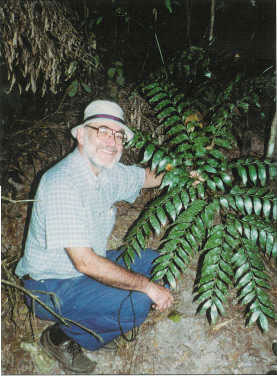 |
| The happy author next to his first wild Bowenia spectabilis, a cycad of the shaded rainforest floor. |
Australian Rainforest Visit
Jack B. Fisher, Ph.D., Senior Research Scientist
In July, I visited Australia for the first time to attend the Third International Congress on Mycorrhiza (ICOM3) in Adelaide. There I presented my latest research findings about beneficial soil fungi in the roots of native South Florida plants. This work represents Fairchild Tropical Botanic Garden's modest role in the worldwide effort to understand the symbiosis between plant roots and fungi. Although only a few of the 450 scientists attending are working on similar research on tropical plants, I was able to network with colleagues from Asia, Australia, Africa and Europe. The four days of symposium talks and workshops covered the newest research and were followed by stimulating discussions. It was intellectually exciting and at the same time, exhausting. The day after the conference, I relaxed by walking in the brisk winter sunshine in the Adelaide Botanic Garden, one of the many beautiful nineteenth century botanical gardens in Australia. The curators were happy to let me collect seeds of a hearty rainforest giant, Podocarpus elatus, which I believe should take Miami's cool winters. Unfortunately, we could not collect the seed at this protected site in a national park.
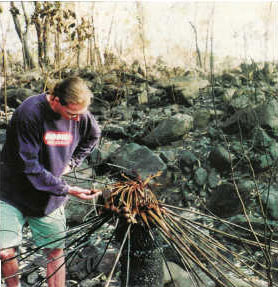 |
| Paul Drake holds a seed of Cycas media after a fire swept through an open grassy area between eucalyptus trees. |
After traveling the great distance from Florida to Australia, I decided it was only sensible to extend my visit to include an exploration of the rainforests of Queensland. During the week following the conference, my home base was the small campus of James Cook University in Cairns, which is at about the same latitude as Southern Mexico, but south, rather than north, of the equator. The mango trees were all in flower, just like ours are in January. With the help of Paul Drake, a knowledgeable and enthusiastic botany graduate student, I visited several rainforest sites along the coast north of Cairns. These rainforests occur only on the narrow strip along the eastern coast of Australia, where mountains wring water from the moist air blowing from the Pacific Ocean. These rainforests, now considered the oldest in the World, contain many extremely primitive plants. Many forests have been cleared for sugarcane or pasture; the remaining forests are well-protected as parks or as part of the World Heritage Site. The forests and the wondrous animal life within them, as well as the corals and fish in the nearby Great Barrier Reef, are the basis for a thriving and economically important ecotourism industry. It is now virtually impossible to collect plant material from these precious forests for research or horticulture, making botanical cooperation and collaboration with local institutions vital.
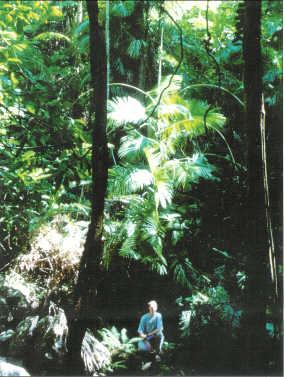 |
| Paul Drake sits at the base of Calamus australis. The local name for this climbing rattan palm is "wait-a-while" or "lawyer vine" because its arched leaves and inflorescences are covered with recurved hooks. |
I was able to legally collect seeds, cuttings and rattan plants for research at a fragment of rainforest on private land. The land owner, a progressive rancher, generously permitted me and other university scientists to use the site for biological research. Paul was studying the use of water by rainforest trees as his research thesis topic. I wanted to see if the two native species of rattan palms produced root pressure in their root systems that might help move water in their long stems. To measure this I have to cut many living rattans at their stem bases and attach instruments to measure pressure.
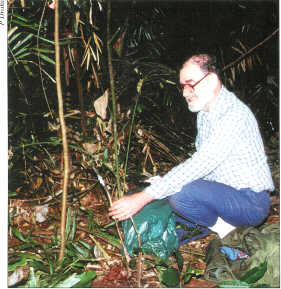 |
| Author measuring root pressure with a simple pipette manometer attached to the cut base of a rattan. |
For three days, we worked on our respective research projects, helping one another when necessary. For two nights, I camped with Paul in a forest filled with the morning and evening chorus — more accurately chaos — of birds I had never heard before: “catbirds” with the volume of boom-boxes, “whip birds” with sounds I only previously heard from electric guitars, and flocks of honking cranes and screaming cockatoos. One night we peered into the canopy with a powerful search light looking for tree kangaroos. We did fmd one, but all I really saw were two glowing orange eyes 50 or more yards above me amongst the tree leaves.
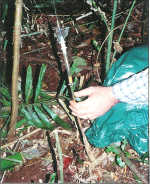 |
| Close-up of author measuring the root pressure of a rattan. |
I was happy with the chance to measure root pressures in rattan, but disappointed to find that rattans have no pressure, unlike climbing lianas of other flowering plants. However, I was gratified by the opportunity to collect seeds and cuttings of rainforest plants and rattan roots for future research. At a local native plant nursery, I purchased seedlings of some 25 additional Australian rainforest species, all new to Fairchild Tropical Botanic Garden. If we are lucky, many will survive the rigors of being bare-rooted and shipped, and will flourish in our Rainforest Exhibit.
Garden Views November 2001